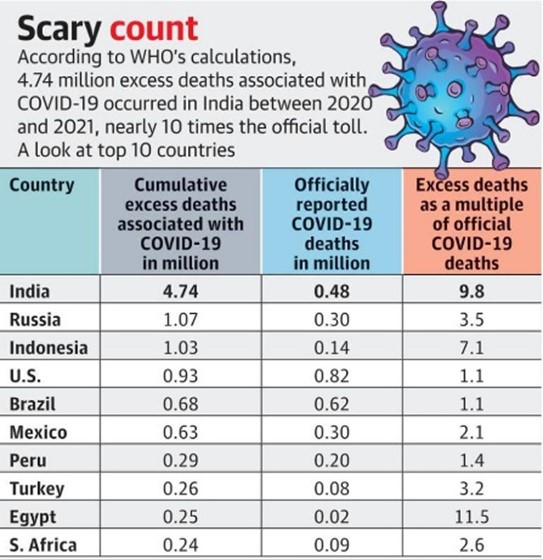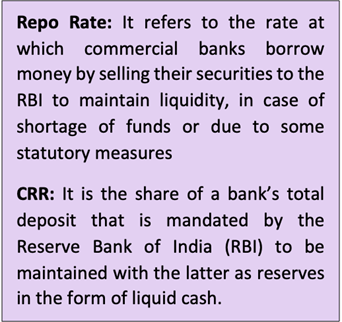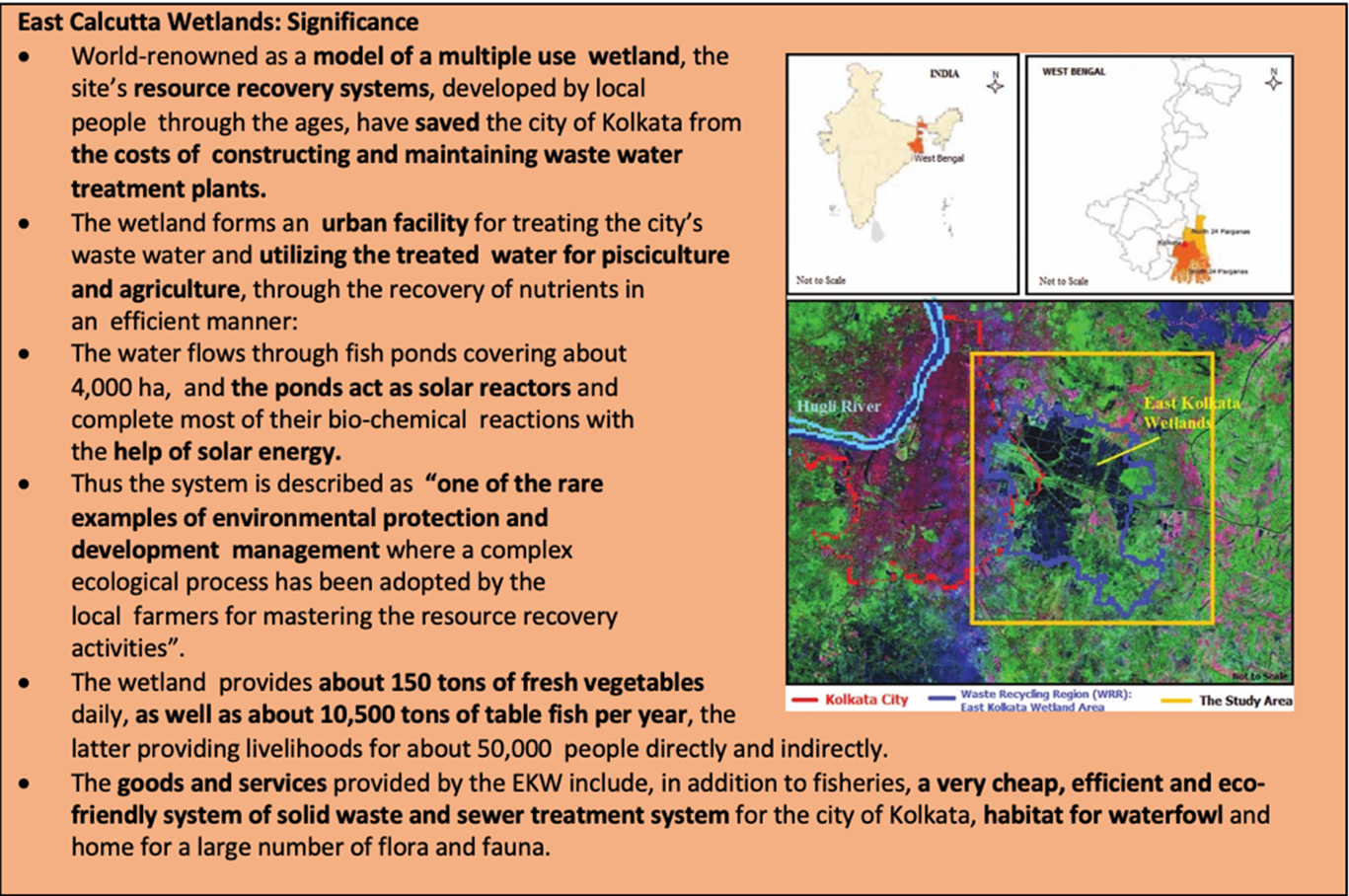Monday, 9th May 2022
Impact of monetary policy changes
In News
RBI has hiked the repo rate amid evolving macroeconomic situation
About the news
- Amid increasing inflationary pressures, the Reserve Bank of India has recently decided to increase the policy rates.
- The RBI steps is perceived owing to inflationary pressures because of external factors such as oil and commodity prices, and supply chain disruptions which has raised the Consumer Price Index-based inflation to as high as 6.95%
- The Monetary Policy Committee (MPC) of RBI has decided to remain accommodative while focusing on withdrawal of accommodation to ensure that inflation remains within the target going forward, while supporting growth.
- These decisions are in consonance with the objective of achieving the medium-term target for consumer price index (CPI) inflation of 4 per cent within a band of +/- 2 per cent, while supporting growth.
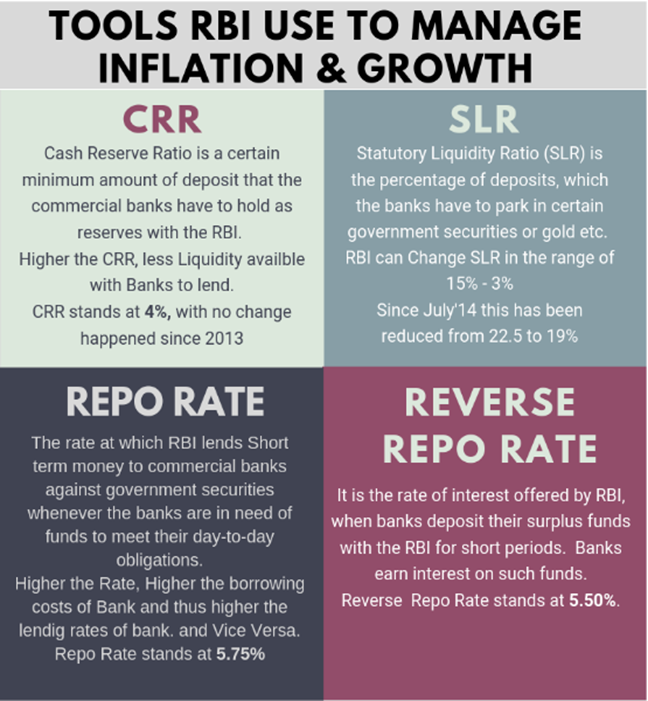
What are the major highlights of the meeting?
- New Policy rates:
- Repo: The repo rate under the liquidity adjustment facility (LAF) has been raised by 40 basis points to 40 per cent with immediate effect.
- Standing deposit facility: SDF rate stands have been adjusted to 4.15 per cent
- Other tools: The new marginal standing facility (MSF) rate and the Bank Rate has been effectively increased to 65 per cent.
- CRR: RBI has also increased the cash reserve ratio (CRR) by 50bps to 4.5%. The CRR is percentage of net demand and time liabilities that banks need to park with the central bank.
What could be the impact of the new changes?
- Costlier loans: Interest rates charged on loans will witness an increase, which in turn would push up production costs.
- Consumption demand: Increased rates will adversely impact consumption demand at a time when demand constraint has been a major hurdle in the revival of the economy.
- Lesser liquidity in market: By raising the CRR by 50bps, RBI is siphoning off ₹87,000 crore from the banking system, thus reducing liquidity levels in the economy.
- Targeting inflation: Increased rates will have a positive impact and help tame inflation, it could also exert further pressure on interest rates.
- Better returns for depositors: With commercial banks raising interest rates, it would work in favor of depositors.
- Impact on common man:
- Costlier EMIs: With increased consumer loans EMIs are set to become costlier. It could lead to demand for consumer durables and housing being discouraged.
- Lesser employment: Poor demand will have an adverse impact on the economy in terms of employment opportunities.
Sources:
New VPN Rules - Edukemy Current Affairs
In News
The Indian Computer Emergency Response Team (Cert-In) a wing of the Ministry of Electronics and Information Technology, issued new directives, that require Virtual Private Network (VPN) providers to store user data for five years.
About the new Rules
- Under the new directions, VPN providers will need to store the following data of the customers for 5 years:
- validated customer names, their physical addresses, email ids, phone numbers
- the reason they are using the service, along with the dates they use it and their “ownership pattern"
- a record of the IP and email addresses that the customer uses to register the service, along with the timestamp of registration.
- VPN providers will have to store all IP addresses issued to a customer and a list of IP addresses that its customers generally use.
- The mandate applies to Virtual Private Server (VPS) providers, VPN service providers, cloud service providers, data centres, and is aimed at maintaining accurate information on customer registrations details.
- The order will become effective after 60 days and failure to furnish the information or non-compliance with the directions, may invite punitive action, CERT-In said.

What kind of data do VPNs log?
- Some VPNs log data required to enforce device caps, measure how much data they have used, and monitor network performance.
- However, many services log browsing data, metadata about a person’s usage, websites they have visited, IP addresses involved, and more.

Rationale behind Government’s mandate
- One of the main reasons that Cert-In provided for seeking these details is that it will help to effectively trace anti-social elements and cybercriminals indulging in various nefarious activities online.
- It also said that these details are necessary to prevent incitement or commission of any cognisable offence using computer resources or for handling of any cyber incident which may lead to any disturbance in the sovereignty or integrity of India, defence of India, security of the state, friendly relations with foreign states or public order.
- It is yet unclear whether the Centre will use this to take action against users accessing content that is blocked in India using VPNs, such as the game PUBG Mobile.
Objections to the move
- Experts have pointed out that governments and their agencies can easily misuse such a rule.
- Journalists, activists, and others who use such services to hide their internet footprint will have difficulty in operating independently.
- They also pointed out that this may actually drive such users towards the dark and deep web, which are much tougher to police than VPN services.
Sources:
Seven Years of Insurance Schemes on social security net
In News
Pradhan Mantri Suraksha Bima Yojana (PMJJBY), Pradhan Mantri Jeevan Jyoti Bima Yojana (PMSBY), and Atal Pension Yojana (APY) have recently completed seven years of providing social security net.
More on the Schemes
Pradhan Mantri Suraksha Bima Yojana:
- Scheme: It is a one-year accidental insurance scheme renewable from year to year offering coverage for death or disability due to accident.
- Eligibility: Individuals in the age group of 18-70 years having a savings bank or a post office account are entitled to enroll under the scheme.
- Benefits: Accidental death cum disability cover of Rs.2 lakh (Rs.1 lakh in case of partial disability) for death or disability due to an accident.
- Enrolment: Enrolment under the scheme can be done by visiting the branch/ BC point or website of the bank of the account holder or at the post office.
- The premium under the scheme is auto debited every year from the subscriber’s bank account based on a one-time mandate from the account holder.
- The scheme is being offered by Public Sector General Insurance Companies or any other General Insurance Company who are willing to offer the product on similar terms with necessary approvals and tie up with banks for this purpose.
- Various Ministries can co-contribute premium for various categories of their beneficiaries from their budget or from Public Welfare Fund created in this budget from unclaimed money. Common Publicity Expenditure will be borne by the Central Government.
- Achievements: The cumulative enrolments under the scheme have been more than 28.37 crore.
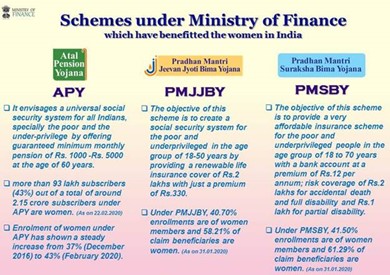
Pradhan Mantri Jeevan Jyoti Bima Yojana
- Scheme: It is a one-year life insurance scheme renewable from year to year offering coverage for death due to any reason.
- Eligibility: Individuals in the age group of 18-50 years having a savings bank or a post office account are entitled to enroll under the scheme.
- People who join the scheme before completing 50 years of age can continue to have the risk of life covered up to age of 55 years upon payment of premium.
- Benefits: Life cover of Rs. 2 Lakh in case of death due to any reason against a premium of Rs. 330/- per annum.
- Enrolment: Same as that of Pradhan Mantri Suraksha Bima Yojana.
- Achievements: The cumulative enrolments under the scheme have been more than 12.76 crore.
Atal Pension Yojana (APY)
- Background:It was launched to create a universal social security system for all Indians, especially the poor, the under-privileged and the workers in the unorganised sector.
- APY is administered by Pension Fund Regulatory and Development Authority (PFRDA) under the overall administrative and institutional architecture of the National Pension System (NPS).
- Eligibility: APY is open to all bank account holders in the age group of 18 to 40 years and the contributions differ, based on pension amount chosen.
- Benefits: Subscribers would receive the guaranteed minimum monthly pension of Rs. 1000 or Rs. 2000 or Rs. 3000 or Rs. 4000 or Rs. 5000 at the age of 60 years, based on the contributions made by the subscriber after joining the scheme.
- Disbursement of the Scheme Benefits: The monthly pension is available to the subscriber, and after him to his spouse and after their death, the pension corpus, as accumulated at age 60 of the subscriber, would be returned to the nominee of the subscriber.
- In case of premature death of subscriber (death before 60 years of age), spouse of the subscriber can continue contribution to APY account of the subscriber, for the remaining vesting period, till the original subscriber would have attained the age of 60 years.
- Payment frequency: Subscribers can make contributions to APY on monthly/ quarterly / half-yearly basis.
- Achievements: More than 4 crore individuals have subscribed to the scheme.
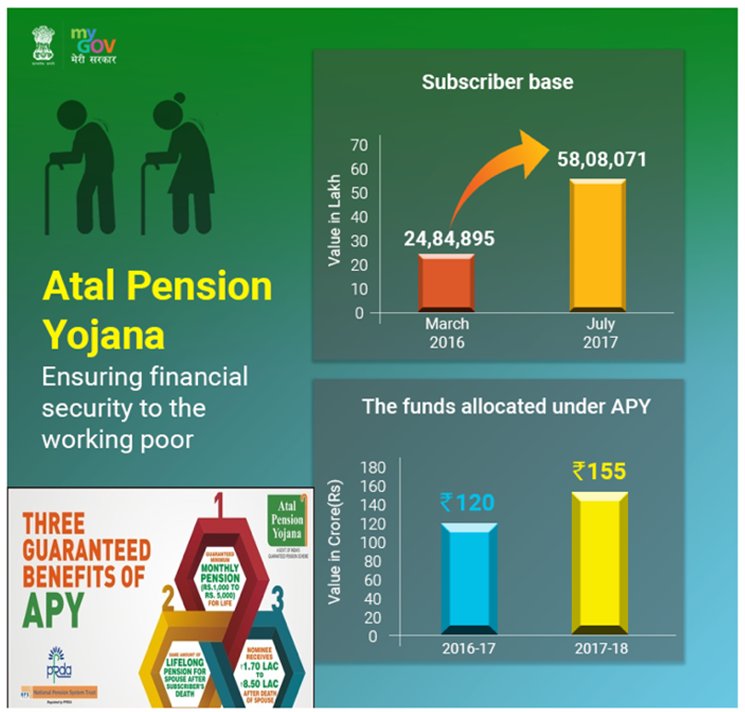
Source:
- PMJJBY, PMSBY, and APY complete seven years of providing social security net
- Pradhan Mantri Suraksha Bima Yojana(PMSBY)
- Programs
Image source:
Maharana Pratap
On May 9, 1540, Maharana Pratap was born. The birth anniversary of the 13th king of Mewar,Maharana Pratap, is being observed across India. His father, Udai Singh II was the 12th ruler of the Mewar dynasty and the founder of Udaipur. Pratap, the eldest child in the family, had three brothers and two stepsisters. Maharana Pratap is known for his military resistance against the expansionism of the Mughal empire and his crucial role in the Battle of Haldighati and the Battle of Dewair. He had defeated Mughal emperor Akbar thrice - in 1577, 1578 and 1579. Maharana Pratap had 11 wives and 17 children. His eldest son, Maharana Amar Singh 1, became his successor and was the 14th king of the Mewar dynasty. Maharana Pratap died at the age of 56 on January 19, 1597, after he was injured in a hunting accident.
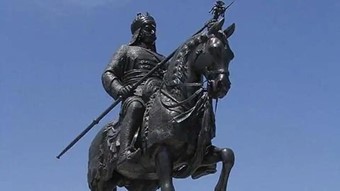
Source:
CRS Report 2020 on Vital Statistics
In News
The Central government published the Civil Registration System (CRS) report 2020 based on birth and death reports in the entire year.
About CRS
- Civil Registration System (CRS) in India is the unified process of continuous, permanent, compulsory, and universal recording of the vital events (births, deaths, stillbirths) and characteristics thereof.
- The Registration of Births and Deaths Act, 1969 provides for the compulsory registration of births and deaths.
- The Registrar General of India (RGI) at the Central Government level coordinates and unifies the activities of registration throughout the country. However, implementation of the statute is vested with the state governments, that appoints functionaries for the process.
- Civil Registration records are the best source of Vital Statistics.
- The data generated through a complete and up to date CRS is essential for socio-economic planning and to evaluate the effectiveness of various social sector programs.
- They also serve as the cornerstone of the public health system.
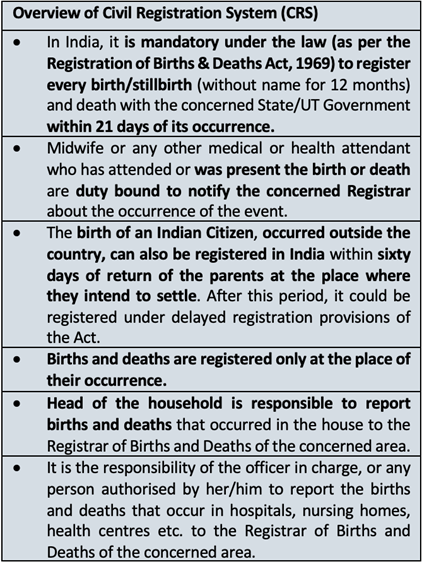
Vital Statistics of India:
- Registered births, dipped from 24.8 million in 2019 to 24.2 million in 2020, a drop of about 2.4 per cent.
- Based on information received from 34 States/UTs, share of institutional births to total registered births is 73.7 %.
- In case of registration of births within the prescribed time period of 21 days, 15 States/UTs including Gujarat, Tamil Nadu, Lakshadweep, Punjab, Haryana, A & N Islands, Himachal Pradesh, Odisha, West Bengal, Andhra Pradesh have achieved more than 90% registration of births to the total births registered.
- 7 States are under the category of less than or equal to 50 percent in completing the birth registration within time limit of 21 days.
- Highest Sex Ratio at Birth (SRB) based on Registered events has been reported by Ladakh.
- The Sex Ratio (Number of females per thousand males) at birth of registered events is an important indicator to map the sex differential of the population at the beginning of their life.
- The number of registered deaths has increased from 7.64 million in 2019 to 8.12 million in 2020.
- In case of registration of deaths within the prescribed time period of 21 days, 11 States/UTs have achieved more than 90% registration of deaths to the total deaths registered.
- 8 States are under the category of less than or equal to 50 percent in completing the birth registration within time limit of 21 days.
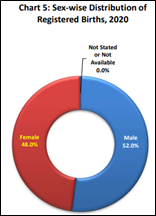
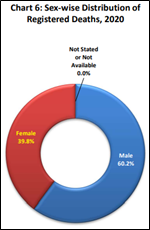
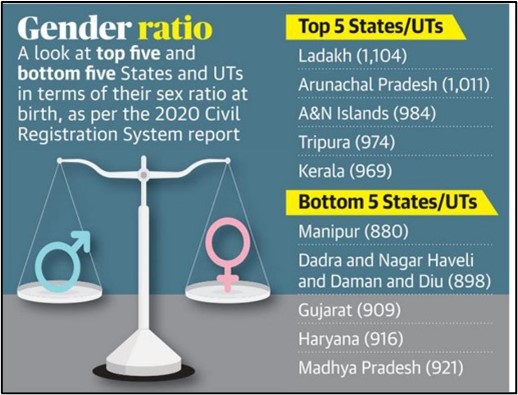
Covid Data and Analysis
- India reported 332,492 deaths due to Covid-19 in 2021, up from 148,994 during 2020, according to the Civil Registration System (CRS) report 2020.
- India’s Covid-19 deaths rose faster in 2021 compared to 2020, and this year the country has already registered 42,207 deaths.
- So far, the country has reported 523,693 deaths in all due to Covid-19 as per the Ministry of Health and Family Welfare (MoHFW) website.
- Deaths per thousand population have come down over the decades, from 14.9 deaths per thousand in 1971 to six in 2020, even though overall death registrations have risen.
- Since death registration is compulsory for property transfers, insurance claims etc, more registrations are done now than before.
- The higher number of Covid-19 deaths in 2021 were due to various factors.
- These included the second wave which was led by the Delta variant, and reduction in Covid-19 appropriate behaviour in the general population. Hence people with greater vulnerability and people with co-morbidities got infected.
- The data also show a sharp decline in deaths recorded in hospitals and other medical facilities in 2020.
- The proportion of people dying in the absence of medical attention increased from 34.5 per cent of all recorded deaths in 2019 to 45 per cent in 2020, the largest single-year jump.
- For several months in 2020, when the pandemic first gripped the world, non-Covid medical services were suspended or operating thinly in India, with 80 to 100 per cent of beds in several hospitals reserved for Covid patients.
- As a result, many people were unable to receive medical care for non-Covid illnesses.
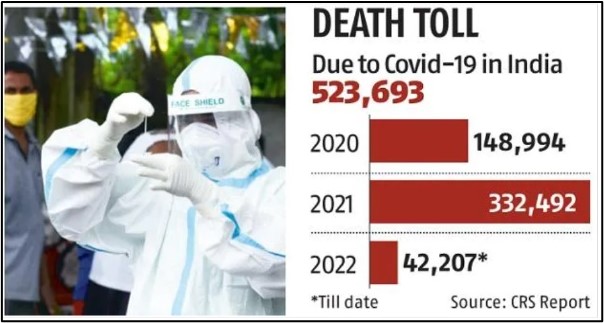
The CRS Report in light of recent WHO Findings
- The ‘excess mortality’ figures released by the World Health Organisation (WHO) says India accounted for over 31% of all ‘excess deaths’ globally in the two covid-19 years of 2020 and 2021.
- India’s excess deaths in the two years, as estimated by WHO, were at least 6.9 times the toll officially attributed to covid-19.
- Pakistan and Bangladesh fared better, with excess deaths that were 1.5 and 1.8 times their official covid death numbers.
- The WHO data is somewhat consistent with other research by scientists and media organizations over the past year.
- All studies conclude that the second wave in the summer of 2021 was particularly fatal, and officially recorded deaths are several times lower.
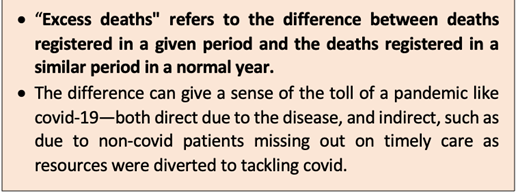
Objections to WHO Data
- The government has pointed out that the completeness of death registry in India has touched 92 percent in 2019 and is now around 99 percent.
- India’s death reporting has improved over the years – from 79 per cent in 2017 to 92 per cent in 2019, and the government claims that 99.95 per cent of all deaths were recorded in 2020.
- According to the CRS 2020, the total number of excess deaths in 2020 is 225,000, an increase of 6% over 2019 and much lower than the WHO estimates.
- Covid deaths were primarily adult deaths, and the reporting of adult deaths in India is quite high. Infant deaths are often under-reported
- The government has objected to the methodology employed by WHO and hence claims that WHO estimates a larger death number for India.
- India has also consistently questioned the WHO’s own admission that data in respect of seventeen Indian states was obtained from some websites and media reports and was used in their mathematical model.
Conclusion: There are differences in the death rates released by the WHO and the government of India. This should be addressed by sharing data between the organisations and a consensus should be reached to assess the real picture of the mortality rates in India. Such figures help in policy making and will help India in assessing and designing health needs for future waves and pandemics.
Question: Discuss the Covid deaths as recorded by the CRS report and differences with the WHO data on the same.
Sources:
- Centre releases India’s civil registration system report for 2020
- VITAL STATISTICS OF INDIA BASED ON THE CIVIL REGISTRATION SYSTEM 2020
- India has registered over 520,000 Covid-19 deaths in all: CRS report
- No medical care for 45% of recorded deaths in 2020, highest ever: New data
- In 2020, Ladakh recorded highest sex ratio in the country, Manipur lowest
- Law Library
- Covid-19: Centre rejects WHO death report, says model flawed
- NITI Aayog member denies claims around inflated COVID deaths, says CRS report represents truth
- Coronavirus: Decoding India's 'excess mortality' according to WHO estimates
- WHO Covid report: Experts say govt statement inaccurate as Centre issues two different death registration estimates
- Increase in death registration in 2020 not entirely due to Covid fatalities: NITI Aayog member VK Paul
- India to contest WHO’s COVID-19 excess deaths report
- What WHO’s data on excess deaths reveals
Ice Volcanoes on Pluto
This is image of a perspective view of Pluto's icy volcanic region based on 2015 data from NASA's New Horizons. The researchers analyzed an area southwest of Sputnik Planitia, Pluto's large heart-shaped basin filled with nitrogen ice. They found large domes 18-60 miles (30-100 km) across, sometimes combining to form more complexly shaped structures. A batch of dome-shaped ice volcanoes that look unlike anything else known in our solar system and may still be active have been identified on Pluto using data from NASA's New Horizons spacecraft. Unlike Earth volcanoes that spew gases and molten rock, this dwarf planet's cryovolcanoes extrude large amounts of ice - apparently frozen water rather than some other frozen material - that may have the consistency of toothpaste. Features on the asteroid belt dwarf planet Ceres, Saturn's moons Enceladus and Titan, Jupiter's moon Europa and Neptune's moon Triton also have been pegged as cryovolcanoes. But those all differ from Pluto's, owing to different surface conditions such as temperature and atmospheric pressure, as well as different mixes of icy materials.

Source:
Shigella Bacteria
- Context: The Kerala health department has identified Shigella bacteria as the cause for the recent food poisoning incidents in Kasaragod.
- Shigella is a bacterium that belongs to the enterobacter family, a group of bacteria that reside in the intestine.
- This bacteria causes Shigellosis - an intestinal infection. However, not all bacteria in the enterobacter family, cause disease in humans.
- It is a food- and water-borne infection, and occurs on consuming contaminated food and is easily spread by direct or indirect contact with the excrement of the affected human.
- There are four types of Shigella bacteria that affect humans: Shigella sonnei, Shigella flexneri, Shigella boydii, and Shigella dysenteriae.
- The symptoms include diarrhoea (sometimes bloody), fever, stomach cramps etc and can be exacerbated during pregnancy and in children under five years of age.
- The infection does not usually result in death, unless the patient has weakened immune system.
- Preventive measures to contain the infection include washing hands regularly, consuming fresh fruits and vegetables.

Source:
- Explained: What is Shigella, the bacteria that killed a girl after she ate shawarma in Kerala?
- Shigella: Bacteria that killed an Indian girl after she ate shawarma in Kerala
Image source
Cyclone Ashani
- Context: The Indian Meteorological Department (IMD) has warned that Cyclone Ashani is likely to intensify into a 'severe cyclonic storm’ over the southeast Bay of Bengal.
- Cyclone Ashani is 'Cyclone System' developed near the South Andaman sea in India, which may develop into a low-pressure area.
- It can develop into a cyclonic storm after changing into deep depression, and hit the coasts of Odisha, West Bengal and Bangladesh.
- Cyclone Ashani is a name given by Sri Lanka that means ‘wrath’ in Sinhalese.
- Cyclonic storms are a result of Tropical Cyclones, which is an intense circular storm that originates over warm tropical oceans and is characterized by low atmospheric pressure, high winds, and heavy rain.
- Accompanying these strong winds are torrential rains and a devastating phenomenon known as the storm surge, an elevation of the sea surface.
- Such a combination of high winds and water makes cyclones a serious hazard for coastal areas in tropical and subtropical areas of the world.
- As sea surface temperatures and humidity both directly correlate with chances of cyclone formation, the Bay of Bengal is a more likely target because it gets higher rainfall, and because the sluggish winds around it keeps temperatures relatively high (about 28 degrees) around the year.
- Thus, Warm air currents enhance this surface temperature and aid the formation of cyclones.
- In addition, the Bay of Bengal receives higher rainfall and constant inflow of fresh water from the Ganga and Brahmaputra rivers. This means that the Bay’s surface water keeps getting refreshed, making it impossible for the warm water to mix with the cooler water below, making it ideal for a depression

Source
- Cyclone Asani to intensify into severe cyclonic storm in next few hours
- Cyclone Asani intensifies into severe storm, IMD issues rainfall alert in 3 states
- Why Is The Bay of Bengal So Prone To Cyclones?
Image source
Rakhigarhi-Harappan civilization
- Context: The three-month-long phase of excavations have been recently completed at Rakhigarhi.
- Rakhigarhi is a 5,000-years-old and one of the largest settlements of Harappan Civilization located in Hisar district of Haryana.
- The site was first excavated by the Archaeological Survey of India in 1998-2001.
- Having a cluster township spread across 500 hectares, it is the largest archaeological site of the Harappan civilisation.
- Also, it has been classified as major metropolitan centre of the Harappan culture.
- Major discoveries at Rakhigarhi include:
- Settlements: The structures of some houses, a kitchen complex and a 5000-year-old jewellery making factory was discovered, which shows that the site must have been a very important trade centre.
- The techniques which are now being used to build big cities like straight streets, drains, dustbins placed at corners of streets for garbage, were used at that time.
- Burials: Graveyards have been found in the excavation sites which explain that civilisation believed in life after death.
- Antiquities: Skeletons of two women were found along with jewellery. Along with skeletons, utensils used by the deceased were also buried.
- Other Artefacts: such as Steatite seals, terracotta bangles, terracotta unbaked sealing with relief of elephant, and Harappan script have been discovered.
- Animal figurines of dog and bull, made of terracotta and steatite, copper objects, steatite beads, beads of semi-precious stones, shells, and objects made of agate and carnelian.
- Settlements: The structures of some houses, a kitchen complex and a 5000-year-old jewellery making factory was discovered, which shows that the site must have been a very important trade centre.
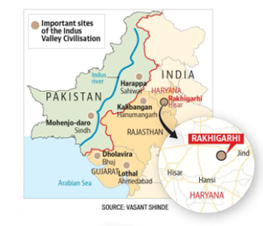
Source
- ASI’s excavation at Harappan site of Rakhigarhi reveals drainage system, copper, and gold jewellery
- 5000-year-old jewellery factory found in Haryana’s Indus Valley site Rakhi Garhi
- DNA samples from Rakhigarhi burial pits sent for analysis
Image source
Rabindranath Tagore
- Context: India celebrates 161st Birth Anniversary of Gurudev Rabindranath Tagore.
- Also known as “Gurudev”, Tagore was a Bengali poet, Brahmo Samaj philosopher, visual artist, playwright, composer, and novelistwhose works reshaped Bengali literature and music in the late 19th and early 20th centuries.
- He played a leading role in Indian cultural renaissance and came to be recognized, along with Mohandas Gandhi, as one of the architects of modern India.
- Tagore was awarded the Nobel Prize for literature for his work ‘Gitanjali‘ in 1913.
- He emphasized self-help and intellectual uplift of the masses, stating that British imperialism was not a primary evil, but instead a "political symptom of our social disease", urging Indians to accept that "there can be no question of blind revolution, but of steady and purposeful education".
- In 1919, following the Jallianwala Bagh massacre, Tagore renounced his knighthood condemning the act.
- Rabindranath Tagore wrote the national anthems of two countries, India and Bangladesh. But he deeply influenced the words and music of a third, the Lankan national anthem, 'Sri Lanka Matha'.
- He influenced by the mysticismof the Upanishads, and the Bhakta- Sufi saints like Kabir and his notable poetry include Manasi (1890) (The Ideal One), Sonar Tari (1894) (The Golden Boat), Gitanjali(1910).
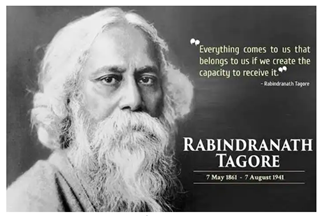
Source
- https://www.cs.mcgill.ca/~rwest/wikispeedia/wpcd/wp/r/Rabindranath_Tagore.htm
- Bangladesh to organise several programmes across country to celebrate 161st Birth Anniversary of Gurudev Rabindranath Tagore May 8
Image source
The multiple crises in Indian universities: The Hindu
Essence: The editorial highlights the crisis of falling educational standards and funding in higher education and steps that are necessary to counter the same. Expenditure in higher education has stagnated at 1.3-1.5% of GDP since 2012. There has been a hold up on creating new teaching post but increase in intake capacity. Drop in discretionary funding, research funding, poor infrastructure, overcrowded classrooms, etc. have led to worsening learning outcomes. Running day to day expenses is happening through loans due to delay in cash flows which were a part of budget. Today, only 2.7% of the 1040 Indian universities offer PhD programs due to infrastructure and funding bottleneck. Due to all this, presently India has 8 universities in Top 500 in the QS World University Rankings.
There has been a drop in students’ motivation due to repeated paper leaks, corruption during examination process, rescheduling of exam, etc. Enthusiasm in university institutions have been related to freedom struggle and anti-corruption movements. But student protests have been met with police brutality and repression.
Awareness, freedom of expression develops critical thinking, and government must aid this process, devoid of which students would escape Indian education and move abroad.
Giving universities autonomy could lead to creating revenue streams like start-up royalties and advertising. Universities must be allowed to decide on the academic programs, promotion, cohort size, etc.
Why should you read this article?
- To know the crisis in funding and quality of education in Indian universities.
- To understand the steps required to foster critical thinking amongst higher education students.
Source:
It is unclear why RBI has hiked interest rates now: Indian Express
Essence: The editorial highlights the confusion around the out-of-turn hike in policy rates by the RBI. RBI is primarily mandated to control inflation by declaring the expected future levels and tweaking the policy rates accordingly. RBI had projected in its last MPC review that inflation would be at 5% levels by the end of this fiscal year and hence, it didn’t bring about any change in the rates. This, despite the rising covid cases in China, impacts of Russia-Ukraine war ad supply chains issues around commodity items.
The sudden spike in repo rate and cash reserve ratio seems to be impact of some other circumstances as well- dollar-rupee exchange rate. US federal reserve’s announcement to increase interest rate by 50 basis point would lead to less presence of dollar in market and hence, depreciation in rupee. RBI has been participating in the FOREX market by selling off dollars to maintain the exchange rate. But this hasn’t been the primary mandate of RBI. Even if RBI was targeting inflation, it should be declaring the new expectations of changes in inflation to make its policy transparent and predictable. Sudden policy rates tweaks convey a message that RBI isn’t under control of monetary policy and isn’t reassuring for the market.
Why should you read this article?
- To understand the reasons for hike in repo rate and CRR.
- To understand the impact of these hikes
Source:
Reviving the spirit of Centre-state alliance: Hindustan Times
Essence: As per the author, the recent fracas between the Centre and states over fuel tax reduction is a consequence of a failure to invest in institutional mechanisms to negotiate intergovernmental ties.
Considering GST experience, negotiating federal cooperation requires political maturity and a commitment to the federal principle. Keeping petrol and diesel, out of GST’s ambit was the compromise made for the states to forgo tax autonomy. However, the Centre has over promised on revenue growth and thus resorted to increasing revenue through cess and surcharge.
From goods and services to capital, labour and natural resources, the national economy is increasingly inter-dependent and cooperation both across states and with the Centre is critical for growth. Thus, investment in Centre-State dialogue is needed as there is an institutional vacuum as NITI Aayog is playing the role of a technocratic body rather than a site for dialogue. Hence, moribund Inter-State Council (ISC) need to be revived to fulfil its constitutionally mandated role of mediating Centre-state relations.
Why should you read this article?
- To understand the consequences of uncooperative federalism.
- To know about the instances where Centre has undermined the terms of cooperation.
- To understand the need for improved Centre State cooperation and the authors recommendation for the same.
Source:
The Success Story of Harshada Garud
Background
Harshada Garud ,who is just 18, won the gold medal in the women's 45kg category with a total effort of 153kg (70kg + 83kg), opening India's account on Day 1 of the competition in Heraklion, Greece.
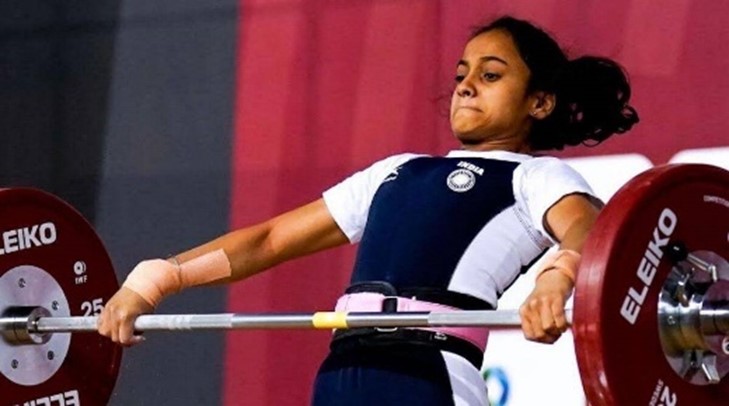
About Harshada’s Success Story
- Harshada from Wadgaon , outside Pune, began weightlifting as a 12-year-old at the behest of her father, Sharad Garud, who was a state-level weightlifter himself.
- Harshada went on to learn the Chinese Clean & Jerk technique, which requires exceptional back power and the capacity to withstand tremendous pressure on the spine, and was then urged to take up the 'Split' approach in Patiala
- Wadgaon is also one of Maharashtra’s weightlifting hubs, apart from Manmad, Sangli and Kolhapur, led by 73-year-old fitness enthusiast Biharilal Dubey who set up basic gymnasiums here in 1972.
- Dubey has been coaching in Wadgaon for 50 years, and would insist that girls get trained in athletics and weightlifting since 1980.
Quote: “There is always going to be a reason why you can’t do something; your job is to constantly look for the reasons why you can achieve your dreams.” – Shannon Miller
Source:
Share the article
Get Latest Updates on Offers, Event dates, and free Mentorship sessions.

Get in touch with our Expert Academic Counsellors 👋
FAQs
UPSC Daily Current Affairs focuses on learning current events on a daily basis. An aspirant needs to study regular and updated information about current events, news, and relevant topics that are important for UPSC aspirants. It covers national and international affairs, government policies, socio-economic issues, science and technology advancements, and more.
UPSC Daily Current Affairs provides aspirants with a concise and comprehensive overview of the latest happenings and developments across various fields. It helps aspirants stay updated with current affairs and provides them with valuable insights and analysis, which are essential for answering questions in the UPSC examinations. It enhances their knowledge, analytical skills, and ability to connect current affairs with the UPSC syllabus.
UPSC Daily Current Affairs covers a wide range of topics, including politics, economics, science and technology, environment, social issues, governance, international relations, and more. It offers news summaries, in-depth analyses, editorials, opinion pieces, and relevant study materials. It also provides practice questions and quizzes to help aspirants test their understanding of current affairs.
Edukemy's UPSC Daily Current Affairs can be accessed through:
- UPSC Daily Current Affairs can be accessed through Current Affairs tab at the top of the Main Page of Edukemy.
- Edukemy Mobile app: The Daily Current Affairs can also be access through Edukemy Mobile App.
- Social media: Follow Edukemy’s official social media accounts or pages that provide UPSC Daily Current Affairs updates, including Facebook, Twitter, or Telegram channels.

